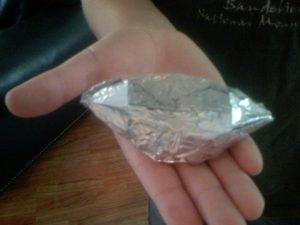 Nu när vädret börjar bli lite varmare kan det var kul att experimentera lite med vatten. I det här fallet bygga en raket.
Nu när vädret börjar bli lite varmare kan det var kul att experimentera lite med vatten. I det här fallet bygga en raket.
Vad du behöver är:
- Filmburk (eller liknande burk med snäpplock)
- Bakpulver
- Vatten
Häll 1 tsk bakpulver i filmburken. Fyll upp till ungefär halva burken med vatten.
Knäpp snabbt på locket, ska filmburken en gång, ställ den upp och ner och ta ett steg tillbaka.
Förklaring
Bakpulver består av cirka 30 % bikarbonat, 40 % någon syra (t.ex. natriumpyrofosfat) samt 30 % fuktmotståndigt ämne (t.ex. majsstärkelse). Bakpulvret reagerar med sig självt när det kommer i kontakt med vatten – bikarbonat och syra reagerar och bildar ett salt (vilket beror på syran) samt
koldioxid.
Koldioxiden är i gasform, vilket innebär att den tar upp stor plats. Ju mer koldioxid som bildas ju mer ökar trycket inne i filmburken (detta höga tryck beror på att koldioxidmolekylerna trängs på en liten volym samtidigt som de kolliderar mycket med varandra och filmburkens väggar). När trycket blir tillräckligt stort skjuter koldioxidmolekylerna ut från filmburken, samtidigt som locket flyger av och filmburken lyfter.
Experimentera
För att göra denna undersökning till ett experiment kan du försöka besvara någon av nedanstående
frågor. Glöm inte att ställa en hypotes och att förklara resultatet.
Blir raketen kraftigare om du använder varmt vatten?
Blir raketen kraftigare om du använder mer vatten?
Blir raketen kraftigare om du använder mer bakpulver?
Blir raketen kraftigare om du använder en större burk med lock, samt mer vatten och bakpulver?
Varianter
- Det går att göra en uppskjutningsramp genom att tejpa fast en tom toarulle på ett styvt papper, och sedan placera filmburken i toarullen.
- Det går även att blanda bakpulver och vatten i en tättomslutande påse och se hur påsen utvidgas (och eventuellt spricker).
- I stället för bakpulver går det att använda någon typ av brustablett, t.ex. Samarin eller en C-vitamintablett. Även dessa innehåller oftast bikarbonat och någon syra.
- Ännu kraftigare blir reaktionen om du i stället för vatten häller i ättikssprit.
Tack till Experimentskafferiet i Sigtuna för det här experimentet.
 Din utmaning är att bygga en båt som kan rymma så många små mynt som möjligt innan den sjunker.
Din utmaning är att bygga en båt som kan rymma så många små mynt som möjligt innan den sjunker.
 The Swedish National Agency for Education (
The Swedish National Agency for Education (
 Now that the weather is getting a little warmer, it can be fun to experiment a bit with water. In this case, build a rocket.
Now that the weather is getting a little warmer, it can be fun to experiment a bit with water. In this case, build a rocket.